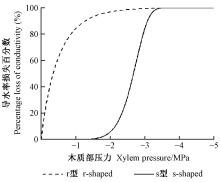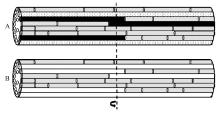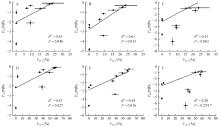

Scientia Silvae Sinicae ›› 2020, Vol. 56 ›› Issue (5): 50-59.doi: 10.11707/j.1001-7488.20200506
• Articles • Previous Articles Next Articles
Han Zhao1,Jin Huang1,Youjing Zhang1,Yanjun Lu1,Zaimin Jiang2,Jing Cai1,3,*
Received:2019-04-23
Online:2020-05-25
Published:2020-06-13
Contact:
Jing Cai
CLC Number:
Han Zhao,Jin Huang,Youjing Zhang,Yanjun Lu,Zaimin Jiang,Jing Cai. Influence of Open Vessel Proportion on the Types of Embolism Vulnerability Curves[J]. Scientia Silvae Sinicae, 2020, 56(5): 50-59.

Fig.1
Schematic representations of xylem embolism vulnerability curves (VCs) (Cochard et al., 2013a) VC can be classified into two groups: "r-shaped" VC (dashed line) and "s-shaped" VC (solid line). "r-shaped" VC shows an exponential rise of hydraulic loss. "s-shaped" VC shows hydraulic conductivity begins to loss only when the xylem pressure reduced to a critical value. "


Fig.2
Diagram of open vessels for centrifugedstem segment (Lopez et al., 2018) A represents stem segment before centrifugation: dash line represents the rotor axis (rotor center); vessels filled with dots represent the vessels with both ends opened; vessels filled with black represent the vessels with one end opened to center; vessels filled with grey represent vessels shorter than the radius of rotor (13.7 cm). B represents stem segment after centrifugation at high xylem negative pressure: all the open vessels (vessels filled with white) drain (embolism artifact) and only intact vessels remain filled with water (vessels filled with grey). "

Table 1
Fitting parameters of embolism vulnerability curves of nine tree species (Mean ± SE)"
| 树种Tree species | 参数Parameters | |||||
| b | c | |||||
| 单威布尔 Single Weibull | 刺槐Robinia pseudoacacia | 0.42±0.04 d | 1.15±0.12 c | |||
| 桑Morus alba | 0.71±0.17 cd | 1.91±0.56 bc | ||||
| 紫薇Lagerstroemia indica | 0.83±0.03 c | 7.11±0.73 bc | ||||
| 元宝槭Acer truncatum | 4.96±0.10 a | 16.17±3.89 a | ||||
| 榛Corylus heterophylla | 2.67±0.03 b | 9.41±0.67 ab | ||||
| λ | b1 | c1 | b2 | c2 | ||
| 双威布尔 Dual Weibull | 女贞Ligustrum lucidum | 48.67±4.22 a | 4.41±1.05 a | 4.26±0.87 a | 2.57±0.89 a | 2.49±0.42 b |
| 桃Amygdalus persica | 12.46±2.33 b | 1.68±0.29 b | 4.86±1.35 a | 3.70±0.05 a | 7.08±0.43 a | |
| 沙棘Hippophae rhamnoides | 55.73±1.35 a | 0.74±0.05 b | 1.77±0.20 a | 3.82±0.18 a | 4.22±0.86 b | |
| 秦白杨I-101×84K | 17.31±2.50 b | 0.97±0.21 b | 3.94±1.54 a | 2.47±0.07 a | 8.99±0.77 a |
Table 2
Embolism vulnerability of nine tree species (Mean ± SE)"
| 类型Type | 树种Tree species | P12/MPa | P50/MPa | P88/MPa |
| 长导管树种 Long-vesselled tree species | 刺槐Robinia pseudoacacia | -0.07±0.01 e | -0.30±0.03 g | -0.86±0.13 e |
| 桑Morus alba | -0.16±0.06 de | -0.50±0.10 fg | -1.29±0.35 e | |
| 紫薇Lagerstroemia indica | -0.61±0.04 cd | -0.79±0.03 f | -0.93±0.03 e | |
| 中导管 Medium-vesselled tree species | 女贞Ligustrum lucidum | -0.59±0.08 cde | -1.77±0.14 d | -6.40±0.51 a |
| 桃Amygdalus persica | -2.11±0.24 b | -3.40±0.05 b | -3.82±0.23 cd | |
| 沙棘Hippophae rhamnoides | -0.33±0.05 de | -1.15±0.05 e | -4.16±0.23 bc | |
| 短导管Short-vesselled tree species | 元宝槭Acer truncatum | -4.25±0.11 a | -4.83±0.09 a | -5.25±0.13 b |
| 榛Corylus heterophylla | -2.13±0.02 b | -2.56±0.03 c | -2.89±0.05 d | |
| 秦白杨I-101×84K | -1.02±0.16 c | -2.30±0.07 c | -2.69±0.09 d |

Fig.7
Relationships between open-vessel fractions and embolism vulnerability P12, P50, P88 represent xylem water potential corresponding to hydraulic loss of 12%, 50%, 88%, respectively. F27.4, F13.7 represent the fractions of both ends opened vessels and one end opened to Cavitron rotor center vessels, respectively.P < 005 indicates statistically significant correlation. "

| 张海昕, 李姗, 张硕新, 等. 4个杨树无性系木质部导管结构与栓塞脆弱性的关系. 林业科学, 2013. 49 (5): 54- 61. | |
| Zhang H X , Li S , Zhang S X , et al. Relationship between xylem vessel structure and embolism vulnerability on four Populus clones. Scientia Silvae Sinicae, 2013. 49 (5): 54- 61. | |
| 张玲玲, 王瑞庆. 简易注气法测定刺槐木质部导管组织长度. 植物科学学报, 2016. 34 (6): 920- 925. | |
| Zhang L L , Wang R Q . Xylem vessel length determination in Robinia pseudoacacia L by simplified air injection. Plant Science Journal, 2016. 34 (6): 920- 925. | |
| Alder N N , Pockman W T , Sperry J S , et al. Use of centrifugal force in the study of xylem cavitation. Journal of Experimental Botany, 1997. 48 (3): 665- 674. | |
| Brodribb T J , Bowman D J , Nichols S , et al. Xylem function and growth rate interact to determine recovery rates after exposure to extreme water deficit. New Phytologist, 2010. 188 (2): 533- 542. | |
| Cai J , Tyree M T . The impact of vessel size on vulnerability curves:data and models for within-species variability in saplings of aspen, Populus tremuloides Michx. Plant Cell and Environment, 2010. 33 (7): 1059- 1069. | |
| Choat B , Badel E , Burlett R , et al. Noninvasive measurement of vulnerability to drought-induced embolism by X-ray microtomography. Plant Physiology, 2016. 170 (1): 273- 282. | |
| Choat B , Brodribb T J , Brodersen C R , et al. Triggers of tree mortality under drought. Nature, 2018. 558 (7711): 531- 539. | |
| Choat B , Drayton W M , Brodersen C , et al. Measurement of vulnerability to water stress-induced cavitation in grapevine:a comparison of four techniques applied to a long-vesselled species. Plant Cell and Environment, 2010. 33 (9): 1502- 1512. | |
| Christman M A , Sperry J S , Adler F R . Testing the 'rare pit' hypothesis for xylem cavitation resistance in three species of Acer. New Phytologist, 2009. 182 (3): 664- 674. | |
| Cochard H , Delzon S , Badel E . X-ray microtomography (micro-CT):a reference technology for high-resolution quantification of xylem embolism in trees. Plant Cell and Environment, 2015. 38 (1): 201- 206. | |
| Cochard H , Badel E , Herbette S , et al. Methods for measuring plant vulnerability to cavitation:a critical review. Journal of Experimental Botany, 2013a. 64 (15): 4779- 4791. | |
| Cochard H , Delzon S . Hydraulic failure and repair are not routine in trees. Annals of Forest Science, 2013b. 70 (7): 659- 661. | |
| Cochard H , Herbette S , Barigah T , et al. Does sample length influence the shape of xylem embolism vulnerability curves? A test with the Cavitron spinning technique. Plant Cell and Environment, 2010. 33 (9): 1543- 1552. | |
| Cochard H , Damour G , Bodet C , et al. Evaluation of a new centrifuge technique for rapid generation of xylem vulnerability curves. Physiologia Plantarum, 2005. 124 (4): 410- 418. | |
| Cochard H . A technique for measuring xylem hydraulic conductance under high negative pressures. Plant Cell and Environment, 2002. 25 (6): 815- 819. | |
| Cochard H , Cruiziat P , Tyree M T . Use of positive pressures to establish vulnerability curves:Further support for the air-seeding hypothesis and implications for pressure-volume analysis. Plant Physiology, 1992. 100 (1): 205- 209. | |
| Dixon H H , Joly J . On the ascent of sap. Philosophical Transactions of the Royal Society B:Biological Sciences, 1895. 186, 563- 576. | |
| Domec J C , Gartner B L . Cavitation and water storage capacity in bole xylem segments of mature and young Douglas-fir trees. Trees, 2001. 15 (4): 204- 214. | |
| Fichot R , Brignolas F , Cochard H , et al. Vulnerability to drought-induced cavitation in poplars:synthesis and future opportunities. Plant Cell and Environment, 2015. 38 (7): 1233- 1251. | |
| Hochberg U , Windt C W , Ponomarenko A , et al. Stomatal closure, basal leaf embolism, and shedding protect the hydraulic integrity of grape stems. Plant Physiology, 2017. 174 (2): 764- 775. | |
| Jacobsen A L , Pratt R B . No evidence for an open vessel effect in centrifuge-based vulnerability curves of a long-vesselled liana (Vitis vinifera). New Phytologist, 2012. 194 (4): 982- 990. | |
| Jansen S , Choat B , Pletsers A . Morphological variation of intervessel pit membranes and implications to xylem function in angiosperms. American Journal of Botany, 2009. 96 (2): 409- 419. | |
| Li S , Klepsch M , Jansen S , et al. Intervessel pit membrane thickness as a key determinant of embolism resistance in angiosperm xylem. IAWA Journal, 2016. 37 (2): 152- 171. | |
| Li Y , Sperry J S , Taneda H , et al. Evaluation of centrifugal methods for measuring xylem cavitation in conifers, diffuse- and ring-porous angiosperms. New Phytologist, 2008. 177 (2): 558- 568. | |
| Liu Y Y , Song J , Wang M , et al. Coordination of xylem hydraulics and stomatal regulation in keeping the integrity of xylem water transport in shoots of two compound-leaved tree species. Tree Physiology, 2015. 35 (12): 1333- 1342. | |
| Lopez R , Nolf M , Duursma R A , et al. Mitigating the open vessel artefact in centrifuge-based measurement of embolism resistance. Tree Physiology, 2019. 39 (1): 143- 155. | |
| Martin-StPaul N , Delzon S , Cochard H . Plant resistance to drought depends on timely stomatal closure. Ecology Letters, 2017. 20 (11): 1437- 1447. | |
| Martin-StPaul N K , Longepierre D , Huc R , et al. How reliable are methods to assess xylem vulnerability to cavitation? The issue of 'open vessel' artifact in oaks. Tree Physiology, 2014. 34 (8): 894- 905. | |
| Martinez-Vilalta J , Garcia-Forner N . Water potential regulation, stomatal behaviour and hydraulic transport under drought:deconstructing the iso/anisohydric concept. Plant Cell and Environment, 2017. 40 (6): 962- 976. | |
| McElrone A J , Brodersen C R , Alsina M M , et al. Centrifuge technique consistently overestimates vulnerability to water stress-induced cavitation in grapevines as confirmed with high-resolution computed tomography. New Phytologist, 2012. 196 (3): 661- 665. | |
| Neufeld H S , Grantz D A , Meinzer F C , et al. Genotypic variability in vulnerability of leaf xylem to cavitation in water-stressed and well-irrigated sugarcane. Plant Physiology, 1992. 100 (2): 1020- 1028. | |
| Pivovaroff A L, Burlett R, Lavigne B, et al. 2016. Testing the 'microbubble effect' using the Cavitron technique to measure xylem water extraction curves. AoB Plants, 8: plw011.doi: 10.1093/aobpla/plw011. | |
| Pockman W T , Sperry J S , Oleary J W . Sustained and significant negative water-pressure in xylem. Nature, 1995. 378, 715- 716. | |
| Sparks J P , Black R A . Regulation of water loss in populations of Populus trichocarpa: the role of stomatal control in preventing xylem cavitation. Tree Physiology, 1999. 19 (7): 453- 459. | |
| Sperry J S . Cutting-edge research or cutting-edge artefact? An overdue control experiment complicates the xylem refilling story. Plant Cell and Environment, 2013. 36 (11): 1916- 1918. | |
| Sperry J S , Christman M A , Torres-Ruiz J M , et al. Vulnerability curves by centrifugation:is there an open vessel artefact, and are 'r' shaped curves necessarily invalid. Plant Cell and Environment, 2012. 35 (3): 601- 610. | |
| Sperry J S , Tyree M T . Mechanism of water stress-induced xylem embolism. Plant Physiology, 1988. 88 (3): 581- 587. | |
| Tobin M F , Pratt R B , Jacobsen A L , et al. Xylem vulnerability to cavitation can be accurately characterised in species with long vessels using a centrifuge method. Plant Biology, 2013. 15 (3): 496- 504. | |
| Tombesi S , Nardini A , Farinelli D , et al. Relationships between stomatal behavior, xylem vulnerability to cavitation and leaf water relations in two cultivars of Vitis vinifera. Physiol Plant, 2014. 152 (3): 453- 464. | |
|
Tombesi S , Nardini A , Frioni T , et al. Stomatal closure is induced by hydraulic signals and maintained by ABA in drought-stressed grapevine. Sci Rep, 2015. 5 (1): 12449.
doi: 10.1038/srep12449 |
|
| Torres-Ruiz J M , Cochard H , Mayr S , et al. Vulnerability to cavitation in Olea europaea current-year shoots:further evidence of an open-vessel artifact associated with centrifuge and air-injection techniques. Physiologia Plantarum, 2014. 152 (3): 465- 474. | |
| Tyree M T, Zimmermann M H. 2002. Xylem structure and the ascent of sap. 2nd ed. Berlin Heidelberg: Springer-Verlag, 96-97. | |
| Urli M , Porte A J , Cochard H , et al. Xylem embolism threshold for catastrophic hydraulic failure in angiosperm trees. Tree Physiology, 2013. 33 (7): 672- 683. | |
| Wang R , Zhang L , Zhang S , et al. Water relations of Robinia pseudoacacia L.:do vessels cavitate and refill diurnally or are R-shaped curves invalid in Robinia. Plant Cell and Environment, 2014. 37 (12): 2667- 2678. | |
| Wheeler J K , Huggett B A , Tofte A N , et al. Cutting xylem under tension or supersaturated with gas can generate PLC and the appearance of rapid recovery from embolism. Plant Cell and Environment, 2013. 36 (11): 1938- 1949. | |
| Wheeler J K , Sperry J S , Hacke U G , et al. Inter-vessel pitting and cavitation in woody Rosaceae and other vesselled plants:a basis for a safety versus efficiency trade-off in xylem transport. Plant Cell and Environment, 2005. 28 (6): 800- 812. | |
| Yin P , Meng F , Liu Q , et al. A comparison of two centrifuge techniques for constructing vulnerability curves:insight into the 'open-vessel' artifact. Physiologia Plantarum, 2019. 165 (4): 701- 710. |
| Viewed | ||||||
|
Full text |
|
|||||
|
Abstract |
|
|||||